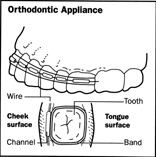Orthodontics - Diagnosis of orthodontic problems
Diagnosis of Orthodontic Problems
Each child should visit a dentist before the eruption of the permanent teeth for an examination that may determine the need for orthodontic treatment. Because there are many genetic and other influences that help shape the facial contours and occlusion of each individual, there are no standard orthodontic procedures that apply to all children. The dentist may recommend what treatment, if any, would be needed to produce normal occlusion and when it should begin; some dentists advise only that necessary procedures for correcting malocclusion be started before the permanent set of teeth (excluding wisdom teeth) has become established, or around the age of 12 or 13. However, there are few age limits for orthodontic care, and increasing numbers of adults are receiving treatment today for malocclusion problems that were neglected during childhood.
In the normal or ideal occlusion positions of the teeth, the first and second permanent upper molars fit just slightly behind the same molars of the lower jaw; all of the teeth of the upper jaw are in contact with their counterparts of the lower jaw. In this pattern of occlusion, all of the biting surfaces are aligned for optimum use of their intended functions of cutting, tearing, or grinding.
There are numerous variations of malocclusion, but generally, in simple deformities, the teeth of the upper jaw are in contact with lower jaw teeth once removed from normal positions. Other variations include an open bite , in which the upper and lower incisors do not contact each other, or closed bite , in which there is an abnormal degree of overlapping ( overbite ) of the front teeth.
Diagnosis is made with the help of X-ray pictures, photographs of the face and mouth, medical histories, and plaster models of the patient's teeth and jaws. The plaster models are particularly important because the dentist can use them to make experimental reconstructions without touching an actual tooth of a patient. For example, the dentist can remove one or more teeth from the plaster model and reorganize neighboring teeth in the jawbones to get an accurate representation of the effects of extracting teeth or forcing teeth into different developmental situations.


Comment about this article, ask questions, or add new information about this topic: